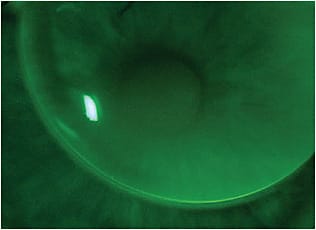Presbyopic patients often have increased visual expectations, but they may provide a strong niche within your practice. When presbyopic patients have moderate-to-high astigmatism or if you suspect that they are visually discriminating, consider GP multifocal contact lenses. Fitting these lenses can potentially add a significant number of underserved contact lens wearers to your office. Many options are available in the multifocal contact lens market, but there are many challenges to consider when choosing the right lens for each patient.
Choose the Best Candidates
Challenges that may result in poor visual acuity with any multifocal contact lenses include:
- On-eye instability
- Poor tear film
- Visual adaptation
- Uncorrected astigmatism
Specifically, uncorrected astigmatism and poor visual clarity can lead to frustration, headaches, and eye fatigue. This is a definite opportunity for GP multifocal lenses—for both your patients and your practice. GP lenses are invaluable for providing a stable visual experience for patients who have any amount of astigmatism. Additionally, GP lenses can mask irregularities of a diseased or irregular corneal surface. For some patients, GPs may be the only effective way to maximize visual function.
Maximize Fitting Success
Ready to give your presbyopic patients GP-quality optics at all distances? The following steps will help ensure GP multifocal fitting success for you and your patients.
- Focus on the fit. Many GP multifocal lens designs have a specific fitting process. Make sure to understand the ideal on-eye placement to maximize success. Some lenses are meant to sit a little higher on the eye (Figure 1), while others are meant to stay more centered during lens wear. A little bit of movement is necessary, but patients will most often have difficulties if GP lenses move too much.

Figure 1. This slightly “lid-attached” high-riding GP fit may be ideal for some lens designs. - Look for ways to maximize surface hydration. Depending on the lens design, know your options for lens material and for treatments that will improve the surface wetting of the lens.
- Follow the fitting guide. This cannot be stated enough. Every multifocal contact lens has gone through extensive research to identify the best fitting strategy before entering the market. Follow that guide to increase your odds for success.
- Develop your protocol. All of the available GP multifocal lens and parameter options offer a unique platform and design, which allows contact lens practitioners to provide a differentiated product to patients. Make sure that your staff can help you streamline the fitting process.
A Worthwhile Addition to Your Practice
Even though GPs can require longer adaptation times, they may be the best option, especially for certain patients. Be confident in the technology and in your patient selection. When the amount of astigmatism reaches a higher level (> 3.00DC), many will need to utilize back-toric or bitoric GPs to improve the lens stabilization on the eye.
GP multifocals can often be fit empirically and usually provide the greatest range of clear vision from near to distance. They may also be the best way to maximize visual function, as these lenses are customized to the patients’ specific cornea and to their specific visual needs. CLS




